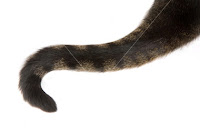Did you know...Cat Body
Nose
• The nose pad of a cat is ridged in a pattern that is unique, just like the fingerprint of a human.
Tail
• If your cat is near you, and her tail is quivering, this is the greatest expression of love your cat can give you. If her tail starts thrashing, her mood has changed --- Time to distance yourself from her.
• Cats wag their tails when it is in a stage of conflict. The cat wants to do two things at once, but each impulse blocks the other. For example: If your cat is in the doorway wanting to go outside, and you open the door to find it raining, the cat's tail will wag because of internal conflict. The cat wants to go outside, but doesn't want to go into the rain. Once the cat makes a decision and either returns to the house or leaves into the rain, the tail will immediately stop wagging.
• The domestic cat is the only cat species able to hold its tail vertically while walking. All wild cats hold their tails horizontally or tucked between their legs while walking.
Heart
• A cat's heart beats twice as fast as a human heart, at 110 to 140 beats per minute
Leg
• A falling cat will always right itself in a precise order. First the head will rotate, then the spine will twist and the rear legs will align, then the cat will arch its back to lessen the impact of the landing.
• The Giraffe, Camel and Cat are the only animals that walk by moving both their left feet, then both their right feet, when walking. This method of walking ensures speed, agility and silence.
• Your cat is probably either a "righty" or a "lefty." Only 40% of cats are ambidextrous while another 40% are either right-pawed or left-pawed.
Body / anatomy
• Cats have 290 bones in their bodies, and 517 muscles.
• A cat has five more vertebrae in her spinal column than her human does
• There are three body types for a cat. Cobby type is a compact body, deep chest, short legs and broad head. The eyes are large and round. Muscular type is a sturdy body and round, full-cheeked head. Foreign type is a slender body, with long legs and a long tail. The head is wedge-shaped, with tall ears and slanting eyes.
• A cat's normal body temperature is 101.5 degrees. This is slightly warmer than a humans.
• A cat's ear pivots 180 degrees. They have 30 muscles in each ear, and use twelve or more muscles to control their ear movement.
• Cats rub up against other cats, and people, in an attempt to "mark" them with their scent glands. They most often use the scent glands between their eye and ear (near the temple area) or their scent glands near the base of their tail.
• The average cat weighs 12 pounds.
• Cats love high places. They share this love with leopards and jaguars, who sleep in trees. If a cat begins to fall, his inner ear canal (which controls balance) will help him right himself and land on his feet.
• Never leave your cat in a vehicle alone. On summer days, temperatures in an automobile can reach 160 degrees in just minutes, even with the windows cracked.
• "PSI trailings" attempt to explain a cat's ability to travel a long distance to return to their home. It is said they use the earth's gravity to determine "their place" in the world, and to develop the ability to return there when necessary
• Stings to the mouth can be very dangerous to cats. If your cat is stung, or ever experiences any type of sting to the mouth, take her to the vet immediately. As her mouth swells from the sting, she may be unable to breath. Stings require urgent medical care.




No comments:
Post a Comment